Much of the discussions this week revolved around differences in socioeconomic status and class. We talked about how racism in the country is embedded in class difference in the U.S. In English, we analyzed several political ads that aimed for certain classes of people. In literature, Great Gatsby was our reading for the week, which deals with the topics of the American Dream and class difference heavily. While the U.S. is often considered a classless society, I found it interesting that our “American Studies” cluster discusses class structure so much.
Ali Shiraef
English 1103H
Author: ashiraef1 (page 1 of 6)
There was not much topical connection amongst the classes this week, yet there was the general ideas of sexism and racism in the country. I believe having the history class might make it easier to make fundamental connections in all the classes, considering our Literature class moves in chronological order, as well as some parts of the government class. While each class kind of took its own direction this past week, I agree with Sam that it wasn’t a bad thing. For example, I think analyzing different time periods of racial relations, Abigail mentioned, helps students better understand the events that occurred and why people did the things they did/felt. Having classes that take on different perspectives for similar problems can help accomplish this.
The main connection made across the classes (excluding history, which I am not a part of) was race and gender inequality. In perspectives and in literature, we talked about feminism and how gender roles are an extremely unmoving standard in society. In the same classes, we discussed race as a basis for prejudice. Racism has quickly become a very prominent topic in the entire cluster, which should say something about how prevalent the idea has been in the country’s history.
In both government and literature, we read/talked about how slavery has influenced this country, specifically its “Founding Fathers” and certain laws such as the Fugitive Slave Act. Government showed us the constitutional and historical side to pre-Civil War slavery, while Literature showed us the philosophy and writings that came from it. We read both Phyllis Wheatley and Frederick Douglass, two very different, but also alike, slaves. In Douglass’s narrative, he writes about what he believes motivates the slave owner to treat his slaves worse or better, and about how the institution itself begs for violence. In government, Dr. Evans broke down the Articles of Confederation, the Constitution, and the Constitution of the Confederate states to show both obvious and discreet ways the federal government protected slavery. We read quotes from men, such as Benjamin Franklin and James Madison, who believed slavery was a “necessary evil” to unite the country. We also discussed men like Alexander Hamilton who believed the institution of slavery was a complete contradiction to the country’s morals. and leaders from the Confederacy who believed the white man was meant to be held superior to other races by nature. Slavery was such a huge part of the country’s history, so it’s only logical that an “American Studies” cluster effectively covers the subject.
This past week, I’ve made many connections between the English class and the seminar, especially because the assignment we worked on in Dr. Wharton’s class required us to gather sources on different parts of the Atlanta region. I had to collect data and resources for the Atlanta Beltline, and along the way I read some interesting pieces on the different transitions of Atlanta through time. I read one specific article that described how Atlanta lacks a certain “flavor” that many other big American cities have, such as New York or Chicago. I believe that in a way, Atlanta is trying to gain some of that flavor back, and by attending this school and, specifically, by taking these classes, we will be able to see the true “flavor” of Atlanta.
Also, the more reading I do, the more I seem to notice the true affect urban sprawl has had on the metro Atlanta area. I am taking a non-cluster course for my major, criminal justice, and I had to read a novel this week about suburban drug dealers. The novel, which has absolutely nothing to do with this course, talked about the major effects urban sprawl has had both on the city itself and on the people.
Urban renewal projects in Atlanta such as the new parks, the Beltline, and Ponce City Market are an interesting attempt at making the city a better place to live and be in. I think it’s important for us to be able to take a step back, and acknowledge the complicated past of Atlanta’s infrastructure changes/projects. I for certain do not know enough about urban infrastructure to know what sort of improvements need to be made to improve the city, but I am hoping to learn more as the courses continue.
In the past week, several of our classes have discussed the idea of the city. In Dr. Fernandez’s class, our assigned comic book “New York: The Big City” illustrates much of the culture and social interaction that exists in a big city such as New York. We discussed how the layouts of cities and the history of their existence have affected humanity and the way we live. In our Mapping class, we read some of “Where We Want to Live”, and talked about how the author, Ryan Gravel, describes the causes and effects of urban sprawl, specifically in the metro Atlanta area. We also discussed other geographical urban issues such as “white flight” and the destruction of multiple residential neighborhoods in the mid-late 1900s. In both classes, we considered the impact the automobile has had on cities and on the country as a whole. Atlanta itself has gone through multiple transformations, from being the locomotive capital of the Southeast, to a city riddled with confusing and complicated highway systems to benefit the individual automobile, to, now, an urban area that is attempting to bring ease back to the pedestrian lifestyle. For example, the multiple expansions of sidewalks and bicycle lanes throughout downtown, or the invention of the Atlanta Beltline and the streetcar system.
The biggest topic our classes had in common in my opinion was racial prejudice. Whether or not racism was a main topic of discussion, it tended to play a part in what we were learning about in the class, such as in our Honors Seminar class. We went for a walk around an area that was previously known as Buttermilk Bottoms, and even though the changes in landscape and architecture was the main topic, it was impossible for America’s history of segregation to not show in the (past) streets of Atlanta. The entirety of the Buttermilk Bottoms neighborhood was bulldozed to create multiple megastructures and larger buildings as a replacement. Since the majority of the residents in the area were black, the act of bulldozing the land can definitely be seen as a way of relocating people the government did not want there. Even though segregation became illegal, whites continued to want the physical separation of races. This aided the causes of such events as the destruction of Buttermilk Bottoms.
In other classes, we directly discussed the topic of race, such as literature and perspectives. In literature, we read a few short stories in which the plot directly revolved around race (“How to Date a Brown Girl, Black Girl, White Girl, or Halfie” and “Southern University, 1962”). In perspectives, we discussed how race is the first thing an American sees in another person. In government, we learned about the history of states that were motivated by racial supremacy.
I believe the topic of racism in American is an incredibly important one, and will most likely be discussed throughout the semester in all of our classes.
Perkerson Park turned out to be my favorite park that I visited. The park is absolutely huge, and has many things to do. The park is very fully encapsulated by surrounding neighborhoods, which I assume is where most of the visitors come from. The full frisbee golf course, multiple softball fields, outstanding playgrounds, useful recreation buildings, nice utilities, and beautiful scenery all make this park worth the visit. While D.H. Stanton had a great feel to it, Perkerson does as well, but with a better feeling of nature and scenery. Plentiful trees and the beautiful stream make it a very woodsy park. On the day I visited, the park was mostly empty. However, it was easy for me to imagine the families and groups of people that most likely come and visit this park, and use it for various activities. I believe parks like this one make a great addition to the connectivity and innovation that the Beltline hopes to accelerate, and that they are very beneficial additions to neighborhoods and cities. Some of downtown Atlanta’s parks are less than appealing, and tend to either be underused, under kept, bland, or all of the above. Perkerson Park, however, proves how a city park should be. A city is a city, and that means the environment has very little trees, nature, water, etc. A park’s job is to create an appealing environment for citizens to enjoy, as well as provide a location for people to partake in activities that there may be no space for in the city. Perkerson Park perfectly defines this kind of park, and that’s why it belongs on the trail of the Beltline.
https://youtu.be/dKz2cR8TgvA
The video above shows a short clip of one of the most prominent sounds I experienced at Perkerson Park. 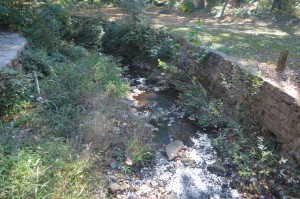
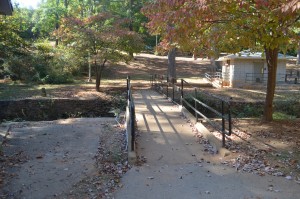
These images show the stream itself, and an example of one of the multiple bridges placed throughout the park that allow park visitors and frisbee golf players to cross over the stream.
I have always loved the sight and sound of running streams, and this park brought me back to my childhood some. Both the immense amount of trees and the stream brought a very nature-oriented feel to this park.
One thing that stood out to me in this park were three humungous pavilions/buildings that appeared to be meant for special events and other recreational activities. The first two images show the building, which I did not get to take a picture of the interior, but it looked very nicely built and appeared to have a basement. The third and fourth images show different pavilion type structures with plenty of seating, trash cans, and grills. The fourth image, if looked at closely, also shows a few men I witnessed filming what appeared to be a music video. The amount of opportunity in this park is very clear with these structures and the environment they are in. The park is undoubtedly an attractive place for the surrounding neighborhoods, families, and communities.
© 2025 Ali Shiraef
Theme by Anders Noren — Up ↑

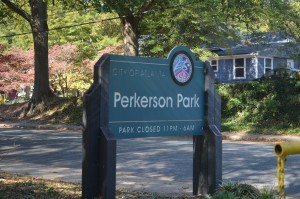
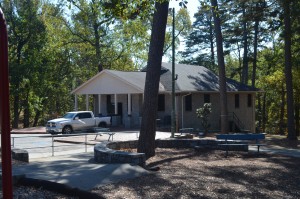
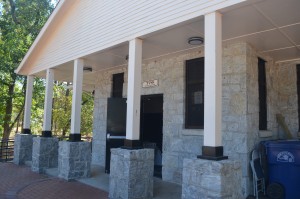
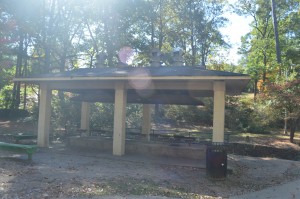
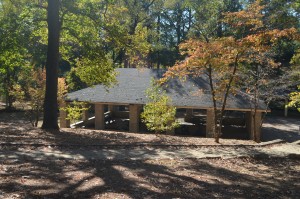
Recent Comments